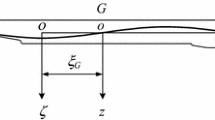Abstract
For the safe design and operation of high-speed craft, it is important to predict the behavior of these craft in following and astern quartering seas as it is well known that serious problems can occur when a vessel is forced by the waves to travel at wave speed. The surf-riding threshold is the lower speed limit above which the vessel will be forced to travel at wave speed (usually on the face of the wave) which is generally accepted to be a prerequisite for broaching. While a vessel travelling below this speed will experience significant changes in its longitudinal speed in the wave, it will not be forced to travel at wave speed. For high-speed craft, the wave-blocking threshold also becomes important. This is the upper speed, below which the vessel will also be forced to travel at wave speed (usually on the back of the wave) and is related to the possibility of bow diving. By the application of a polynomial approximation to the wave-induced surge force, including the nonlinear surge equation, an analytical formula to predict both the surf-riding and the wave-blocking thresholds is proposed. Comparative results of the surf-riding threshold and wave-blocking threshold predicted utilizing the proposed formula and the thresholds predicted using numerical bifurcation analysis indicate fairly good agreement. In addition, previously proposed analytical formulae are examined. It is concluded that predictions of these thresholds obtained using the analytical formulae based on a continuous piecewise linear approximation and Melnikov’s method agree well when used to predict these thresholds with predictions obtained from numerical bifurcation analysis and those obtained experimentally using free-running models. As a result, it is considered that these two calculation methods could be recommended for the early design stage tool for avoiding broaching and bow diving.












Similar content being viewed by others
References
Renilson MR, Driscoll (1982) ‘Broaching––an investigation into the loss of directional control in severe following seas’, Transactions of RINA
Umeda N (1999) Nonlinear dynamics on ship capsizing due to broaching in following and quartering seas. J Mar Sci Technol 4:16–26
Umeda N, Matsuda A, Hamamoto M, Suzuki S (1999) Stability assessment for intact ships in the light of model experiments. J Mar Sci Technol 4:45–57
Hannon M, Renilson MR (2000) ‘Behaviour of a high speed catamaran in Following seas’, NAV 2000, International Conference on Ship and Shipping Research, Venice
Renilson MR, Cooper A, Hannon M (2000) ‘The effect of the cross deck structure on deck diving of high-speed catamarans in following seas’, In: Proceedings of 7th International Conference on Stability of Ships and Ocean Vehicles, Launceston, Tasmania, pp 511–521
Hannon M, Renilson MR, Cooper A (1999) ‘Deck diving of high speed catamarans in following seas: effect of cross deck structure configurations’, 5th International Conference on Fast Sea Transportation, Seattle
Renilson MR, Anderson V (1997) ‘Deck-diving of catamarans in following seas’, In: Proceedings of the forth International Conference on Fast Sea Transportation, Sydney, pp 463–469
Kan M, Saruta T, Taguchi H et al (1990) Capsizing of a ship in quartering seas (part 1). J Soc Naval Archit Jpn (in Japanese) 167:81–90
Spyrou KJ (1996) Dynamic instability in quartering seas-part II: analysis of ship roll and capsize for broaching. J Ship Res 40(4):326–336
Maki A, Umeda N (2009) Bifurcation and Chaos in Yaw motion of a ship at lower speed in waves and its prevention using optimal control, In: Proceedings of the 10th International Ship Stability Workshop, St. Petersburg, pp 429–440
Germany, Report of the Intercessional Correspondence Group (part 1) (2005) SLF48/4/1, IMO (London), pp 1–29
Holmes PJ (1980) Averaging and Chaotic motions in forced oscillations. SIAM J Appl Math 38(1):65–80
Maki A, Umeda N, Renilson M, Ueta T (2010) Analytical formulae for predicting the surf-riding threshold for a ship in following seas. J Marine Sci Technol 15(3):218–229
Spyrou KJ (2001) Exact analytical solutions for asymmetric surging and surf-riding, In: Proceeding of 5th International Workshop on Stability and Operational Safety of Ships, University of Trieste, Trieste, pp 4.5.1–4.5.3
Maki A, Umeda N, Ueta T (2010) Melnikov integral formula for beam sea roll motion utilizing a non-hamiltonian exact heteroclinic orbit. J Mar Sci Technol 15(1):102–106
Umeda N, Yamamura S, Matsuda A, Maki A, Hashimoto H (2008) Model experiments on extreme motions of a wave-piercing tumblehome vessel in following and quartering waves. J Jpn Soc Naval Archit Ocean Eng 8:123–129
Maki A, Umeda N (2008) Numerical prediction of the surf-riding threshold of a ship in stern quartering waves in the light of bifurcation theory. J Marine Sci Technol 14(1):80–88
Umeda N (1990) Probabilistic study on surf-riding of a ship in irregular following seas, In: Proceedings of the 4th International Conference on Stability of Ships and Ocean Vehicles, University Federico II of Naples, pp 336–343
Acknowledgments
The work was supported by the US Office of Naval Research Contract No. 0014-06-1-0646 under the administration of Dr. Patrick Purtell. This research was partly supported by a Grant-in-Aid for Scientific Research of the Japan Society for Promotion of Science (No. 24360355). The authors express their sincere gratitude to the above organization. Further, the authors are grateful to John Kecsmar from Ad Hoc Marine Designs Ltd. for his comprehensive review for preparing his paper as an expert in small craft technology and native English speaker.
Author information
Authors and Affiliations
Corresponding author
Appendix. Proof that the phase of the sinusoidal function can be neglected in the surge equation
Appendix. Proof that the phase of the sinusoidal function can be neglected in the surge equation
The simplified surge equation is as follows:
where ξ P represents the phase of wave-induced surge force. When
the following can be obtained:
Comparison of A1 and A3 demonstrates that the phase, ξ P , does not affect the surf-riding threshold.
About this article
Cite this article
Maki, A., Umeda, N., Renilson, M. et al. Analytical methods to predict the surf-riding threshold and the wave-blocking threshold in astern seas. J Mar Sci Technol 19, 415–424 (2014). https://doi.org/10.1007/s00773-014-0257-2
Received:
Accepted:
Published:
Issue Date:
DOI: https://doi.org/10.1007/s00773-014-0257-2




